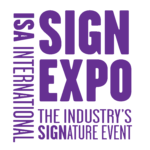YOUR SIGN IS YOUR #1 MARKETING TOOL
Because signs are so commonplace, many merchants take them for granted. Look at signage as a way to mark and also market your business.
For example, researchers from the Sign Research Foundation have determined that the addition of one sign at every fast-food outlet in Los Angeles would raise business revenues by $132 million, and those businesses would in turn pay an additional $10 million in sales tax revenue to the local municipality.
While your on-premise sign should identify your business, mark its location and convey the right image of your company, the most important thing it should communicate is what you are selling.
Here are the ABCs of signage as your #1 marketing tool:
GET IT RIGHT!
Start with an industry professional to help create the right brand for your business while navigating zoning and other regulations.
A: ATTRACT NEW CUSTOMERS
GENERATE NEW CUSTOMER INTEREST
85% of your customers live or work within a five-mile radius of your business. If you want to grow your business, you should focus on this customer base. The quickest, easiest and most economical way to do this is with signage.
What’s the payoff? According to Consumer Perceptions of Signage and Economic Value of On-Premise Signage:
- Increase sales by double digits (16% increase in weekly sales were reported for one business that combined a major building sign modification with two additional minor changes.)
- Reach drive-bys with increased visibility ─ the 54% of shoppers (a four-year study average) who say they have driven by and failed to find a business because the sign was too small or unclear. Both older and younger age groups have reported this problem.
- Reach new customers with quality design (33% of shoppers, a four-year study average, say they have been drawn into unfamiliar stores based on the quality of their signs). Past studies have shown that the 18-24 age group is more prone to this behavior, with more than half in agreement.
Find a skilled industry professional to help create the right brand for your business to attract new customers.
B: BRAND THE BUSINESS
GET RECOGNIZED
A company’s signage helps a customer recognize its brand, just as labels on a grocery store shelf make a product instantly recognizable.
Make sure the name of your business, logo, company colors, catch phrase, etc., are consistent everywhere they’re used: on your sign, letterhead, business cards and print ads etc. This builds recognition and helps brand your business firmly in the mind of the consumer. Think of the McDonald’s® “golden arches” as a time-tested example. No matter where in the world you are, that signage represents consistency in service, experience and product.
Consider, too, that your sign design can be copyrighted, which increases its value as a commercial asset ─ keeping your overall message from being diluted by similar designs.
Your sign can also convey so much about your business and the services you offer. Even from the outside, the sign can help signal exactly what the customer will find once he or she steps in the door.
What’s the payoff? According to Consumer Perceptions of Signage and Economic Value of On-Premise Signage:
- 34% of North American shoppers associate sign quality with store and product quality.
- 29% of North American shoppers make store choices based on the information communicated by store signs.
- 38.5% of shoppers (four-year study average) say they have made quality assumptions about a business based on whether that company has clear and attractive signs. Again, those in the 18-24 age group have been most prone to making such inferences.
Find a skilled industry professional to help create the right brand for your business.
C: CREATE IMPULSE SALES
CAPTURE CUSTOMERS' SHARE OF SHOPPING
Today’s consumers are more likely to shop online or at the first convenient place they see that seems to be selling what they need. Who hasn’t been driving down the street, stopped at a store and made a purchase, merely because they saw the sign?
Best Buy® discovered that about 17% of its customers were people who did not intend to stop there but did so specifically because they saw the sign.
If your sign is going to convince the impulse customer to stop at your business, design it so that important information is easily recognized at a glance.
People driving down the street can take in a great deal of information. 75% will pick out the key word on a sign the first time they pass it.
Make sure the first time someone reads your sign they immediately understand the most important information – what you are selling. Any additional information should be designed to keep your repeat customers interested in your sign and your business so they remember to come see you.
Find a skilled industry professional to help create the right brand for your business to bring in impulse shoppers.






